Growin’ Up Fast
The Early Days Of Gene Winfield
By Dick Martin
Photography: Courtesy of Gene Winfield
You know him for his custom car creations and trend-setting painting techniques, but did you know that Gene "Windy" Winfield was as hardcore a hot rod racer as ever strapped on a helmet? This is the story of Winfield's racing days.
Gene Winfield was born in 1927 in Springfield, Missouri. When he was 18 months old, his family moved to Modesto, California. At 15 years of age, Gene got his first car--a Model A coupe. There wasn't a lot of hot rodding activity in Modesto during wartime, and Gene experienced the same frustration as any kid growing up far from the action. His car didn't have a radio, but Gene installed an antenna anyway, just so he could hang a foxtail from it. "I put 'wig-wag' taillights and goofy stuff like that on the car," says Gene. "Then I started hopping up the engine, put a straight-pipe on it, and did a little bit of street racing with it," Gene recalls.
Any hot rodder worth his ducktail haircut knew that real racers had roadsters. Gene was no exception, so he bought a '30 Model A roadster. Some of the cars from the San Francisco/Oakland area gave him a glimpse of what was happening a million miles away in the big cities. Without the luxury of Hot Rod magazine to guide the way (it wouldn't debut until several years later), Gene had to learn by doing. "I put a '37 Ford flathead V-8 in the roadster, shaved the heads, and made my own intake manifold out of flat plate and tubing, brazed together with brass," Gene says. "I really didn't know how to weld, but I was learning with a gas torch. I warped the bottom and had to get it machined to fit, but I got it to work."
Gene remembers seeing a beautiful Carson-topped '40 Ford with its hood up in the parking lot of a roller rink. Someone had tried to steal the intake manifold, and when the angry owner took off he did something Gene had never witnessed before. "He did the slickest speed shift I had ever seen, so I had to go home and learn how to speed-shift," laughs Gene. "I went through seven transmissions, three rearends, and a few axle-keys before I finally learned to do it."
After selling the A, Gene began building a '27 T roadster. To get the on-the-ground look he wanted, he Z'd the Model A frame in the front and rear, something very few guys had tackled by that time.
Into Business
After a short stint in the Navy, Gene returned to Modesto to try his hand at customizing. "I began doing bodywork around 1946. I started by modifying a '32 grille," Gene remembers. "I did it three times before I got it right. I basically taught myself how to weld and how to work with lead." He opened his first shop, Windy's Custom Shop, in a converted chicken house behind his mother's house.
Now that he had a business, young Gene decided to visit the capitol of hot rodding: Los Angeles. In L.A., Gene took pictures of every customized car he saw. "I took pictures of any car that had a nose job, deck job, skirts…anything. I started following this beautiful '34. I was driving my mother's Plymouth and couldn't catch it, but it finally stopped in front of So-Cal Speed Shop and the driver got out. It was Alex Xydias. I started buying intake manifolds and Winfield cams from him and selling them at home." In 1948, when Gene heard about a new magazine called Hot Rod, he negotiated to sell it in his area. Through the magazine, he learned about the dry lakes and how the fast cars were running at places like El Mirage.
To The Lakes
It seemed like a long way from Modesto to the dry lakes, but Gene was determined to race there. "I decided to run my '27 T at El Mirage, but I had a small motor," says Gene. "I bored it 0.060-inch over on a '59 AB block to 248 ci. Before my first trip to El Mirage in May 1949, I towed my roadster over to the SCTA [Southern California Timing Association] office in L.A.. Before I got the motor shut off, Wally Parks was out the door looking at my car. He couldn't believe it could be so low and still be on top of the rails. I had Z'd the frame at the rear, sculpted it, and radiused it. I cut the outer rails out (leaving the top and bottom rails), welded in a new piece, ground it down, and rounded the edge so the frame looked like a stamped piece. He was dumbfounded," laughs Gene. "But the body was on top of the rails, so I ran in the Modified Roadster class."
Doane Spencer was working at Xydias' shop and helped Gene set up the car to run at El Mirage. "He covered the tire pressure, the jets…everything," Gene remembers. Gene ran the tallest tires he could find, which at the time were 820/16 recaps. Spencer told him he could go 120 mph with his setup. Gene thought he'd be lucky stretching it to 100, but 120? No way. Spencer's mechanical brilliance awed Gene and benefitted him at the lakes. Doane cautioned him about a notorious bump on the lakebed that would scare him and make him release the throttle. "Sure enough," he remembers, "I hit a bump and thought I was flying and I backed off the throttle. I got my foot back in it and turned 112 mph.<
"Every time I ran El Mirage I'd pull the heads and manifold, clean the carbon off the pistons, and polish the intake ports like chrome. I'd bolt it together, fire it once, take it to the dry lakes, fire it, and run it. No changes, no spark plugs, nothing. I'd change the plugs once a year. I ran four gallons of 91-octane aviation fuel to one gallon of Benzol, which I got at the paint store. I used that combination everywhere I ran."
Gene became active in the Cal-Neva Roadster Association and raced at the Reno Lakes Meet races in June 1949, driving his bare-bones Merc-T from Modesto with nothing more than a pillow between him and the springs of his non-upholstered seat. The mile-long lakebed was short compared to the expansive Mojave Desert's lakes. At 5,000 feet elevation, it was also high. Gene brought the skills he'd acquired running with the big boys from L.A. and turned an incredible 114.4 mph. Nobody could touch him.
On To The Salt
Competitors in the early SCTA days at Bonneville were the true legends of hot rodding. Gene was one of them. "I went to Bonneville in 1951 with my '27 T coupe, which ran in the B Modified Coupe class," says Gene. "It looked a little strange, so I called it The Thing. I chopped it 12 inches and slanted the windshield. It had a small engine. The front tires were Montgomery Ward farm-implement tires, rated at 50 mph--I turned 128 mph with them. I borrowed a Howard fuel-injection unit from a guy and I tried running fuel. I didn't know a thing about nitro; it took me three days to get it to run. I had to adjust the fuel-line pump pressure to 28 pounds into the fuel tank. I played with that sucker 'til I finally turned 134 mph, then 135. I have two timing slips from Bonneville and I got a trophy for Third Place in my class. The Pierson Brothers ran their coupe in my class and ran about 150 mph."
Aftermarket parts were scarce until the '50s, so hot rodders fabricated their own parts. Gene made dropped axles and fixtures. Others saw his work and wanted him to make axles for them, too. He built about 30 before calling it quits. A few years ago, he spotted one of his old axles at a car show swap meet. When he informed the seller that he had made it years before, he was asked for his autograph.
Going in Circles
"The first time I tried oval racing was in this old Hudson with a flathead six," Gene says. "A guy brought the car to me and I put in a rollbar and some seatbelts and made a towbar for him. He was running at a track in Madera and wanted me to go with him and be on his pit crew. He took it out on the track and was so slow, he wasn't even squealing the tires. I said, 'Is that as fast as you can make that thing go?' He said, 'If you think you can go any faster, you drive it.' So I did. I got 16th out of 30 cars in the main event and was hooked on 'hardtop racing,' as they called it."
Gene was drafted again during the Korean conflict and was stationed at Fort Ord, California, as a cook. With weekends off and home only a hundred miles away, he was able to keep going to El Mirage and even to Bonneville. In 1952, he was shipped to the Far East. While in Japan, he took part in the first American stock car race to take place there.
Moving Into Customs
When the '49 Merc hit the scene, it was the answer to the custom car guys' prayers. It was a beautiful car and a natural for a whole new look. Out came the torches and down came the roofs. Southern California had its speed-equipment guys, but the custom car guys came from the north. George and Sam Barris started in Sacramento. Joe Bailon, known as the creator of candy apple red paint, was also a NorCal guy. It wasn't long before Gene had one of the first chopped Mercs in the area. In fact, Gene is among that esteemed first generation of customizers who taught Detroit what was happening in the custom world. But that's another story.
Here and Now
Gene Winfield has recently moved his shop to Mojave, California, on the edge of Death Valley, and not far from the dry lakes where he raced as a youth. He's in his 70s now, but Gene neither looks nor acts his age--he doesn't have time. He keeps busy with his shop, building chopped fiberglass Merc bodies and restoring some of his old show cars. In addition, Gene's a regular attendee at the Hot Rod Reunion in Bakersfield, California. In fact, his racing accomplishments were recognized in 2001 with an NHRA Life Achievement award. Gene can usually be found at the annual SEMA industry show in Las Vegas, and never misses the L.A. Roadster Show every Father's Day in Pomona, were he sells many of the same hot rodding accessories he cherished as a teen.
Only a handful of men share the type of artistry that has made Gene Winfield's name and creations endure. Although his legacy will be his custom cars, make no mistake about it--Windy's roots are pure hot rod.
|
|

That’s Gene next to the white primered ’47 Ford with an Olds grille, which he customized for Al Serpa. This photo was used as the cover of the second issue of Rod & Custom in June 1953.
|
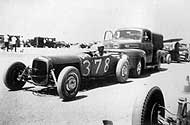
Here, at his first SCTA meet at El Mirage in May 1949, Gene is being pushed off by his ’49 Ford pickup. His best time of the event was 121.45 mph. A month later, he drove his roadster to Reno for the June Cal-Nev Roadster Association meet, removed the lights and windshield, and ran the fastest time of the meet at 114.40 mph. Back at El Mirage in July, he ran 124.13 mph.
|

Here’s Gene on the way to San Francisco right after he joined the Navy in 1944. Years later, when Gene was drafted during the Korean conflict, he managed to fit the Navy into his racing schedule, which included driving stock cars in Japan.
|
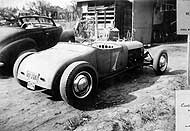
Gene parked his A-framed ’27 T next to his ’39 Merc convertible in front of his first shop. The building was a converted chicken coop. This remarkably low car competed at El Mirage and Reno in 1947 and 1948.
|
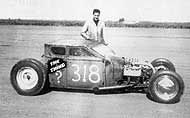
Gene was as active a racer as anyone around. He did it all, from the dragstrips to the dry lakes, then on to the circle tracks, and finally, 50 years ago, to Bonneville. In 1951, Gene ran an impressive 135.542 mph across the salt in his T, nicknamed The Thing, which was built from the ground up. Five custom car hall of fame committees have rightfully honored Gene. We feel one is missing: The Dry Lakes Hall of Fame.
|
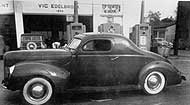
During his first visit to Los Angeles, Gene, always with his trusty $6 camera, shot Earl Bruce’s ’40 Ford in front of Vic Edelbrock’s gas station. This is the trip during which Gene met Wally Parks at the SCTA office, Alex Xydias and Doane Spencer at So-Cal Speed shop, and Bobby Meeks and Edelbrock Sr. at the gas station. Three stops, five legends—not bad.
|
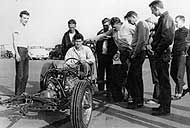
Dick Kraft’s The Bug and Peggy Hart’s dragster had nothing on Gene’s first rail job. Gene won the Top Eliminator class at Kingdon Drag Strip in Lodi, California.
|
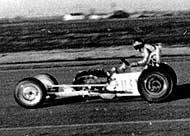
It took lots of courage to sit on top of two framerails and turn 111.60 mph in the quarter.
|
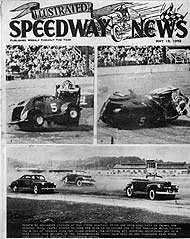
The boy from Modesto shows them how it’s done. The shot at the bottom of this magazine cover is from the first American stock car race ever held in Japan in May 1952. Gene, stationed there during the Korean conflict, takes the low line, and ultimately the win, in a chopped and sectioned ’41 Ford.
|
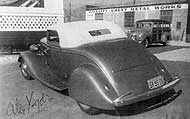
This is the awesome ’34 cabriolet that Gene followed through Los Angeles, right to the parking lot of the So-Cal Speed Shop. Gene was impressed by Alex Xydias’ car, particularly the rear fenders, which were solid and had to be unbolted to remove the rear wheel. A future custom car guy chasing a hot rod guy driving a custom. Interesting.
|
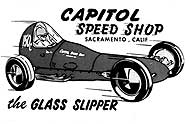
Advertising Windy’s Custom Shop on his ’37 Ford took some daring.
|

Gene had trouble with this car’s handling until he stuffed it into the pit gate’s 2x6. It handled much better after that, according to Gene.
|
|



 Gene Winfield
Gene Winfield
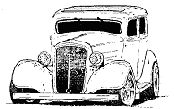


 Gene Winfield
Gene Winfield